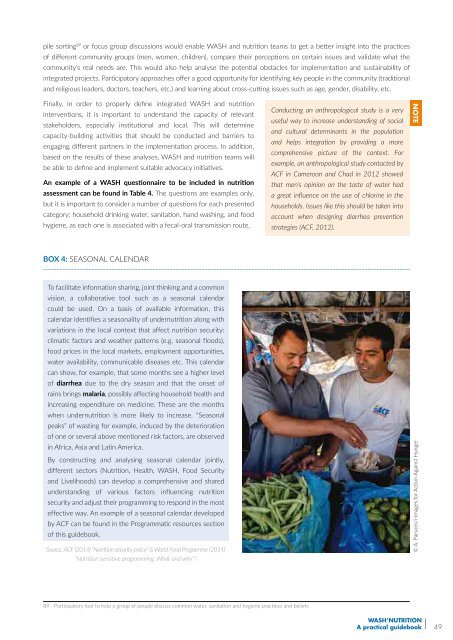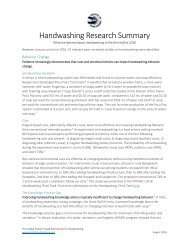WASH’ Nutrition
manuel_wash_nutrition_online
manuel_wash_nutrition_online
Create successful ePaper yourself
Turn your PDF publications into a flip-book with our unique Google optimized e-Paper software.
pile sorting 89 or focus group discussions would enable WASH and nutrition teams to get a better insight into the practices<br />
of different community groups (men, women, children), compare their perceptions on certain issues and validate what the<br />
community’s real needs are. This would also help analyse the potential obstacles for implementation and sustainability of<br />
integrated projects. Participatory approaches offer a good opportunity for identifying key people in the community (traditional<br />
and religious leaders, doctors, teachers, etc.) and learning about cross-cutting issues such as age, gender, disability, etc.<br />
Finally, in order to properly define integrated WASH and nutrition<br />
interventions, it is important to understand the capacity of relevant<br />
stakeholders, especially institutional and local. This will determine<br />
capacity-building activities that should be conducted and barriers to<br />
engaging different partners in the implementation process. In addition,<br />
based on the results of these analyses, WASH and nutrition teams will<br />
be able to define and implement suitable advocacy initiatives.<br />
An example of a WASH questionnaire to be included in nutrition<br />
assessment can be found in Table 4. The questions are examples only,<br />
but it is important to consider a number of questions for each presented<br />
category: household drinking water, sanitation, hand washing, and food<br />
hygiene, as each one is associated with a fecal-oral transmission route.<br />
Conducting an anthropological study is a very<br />
useful way to increase understanding of social<br />
and cultural determinants in the population<br />
and helps integration by providing a more<br />
comprehensive picture of the context. For<br />
example, an anthropological study contacted by<br />
ACF in Cameroon and Chad in 2012 showed<br />
that men’s opinion on the taste of water had<br />
a great influence on the use of chlorine in the<br />
households. Issues like this should be taken into<br />
account when designing diarrhea prevention<br />
strategies (ACF, 2012).<br />
NOTE<br />
BOX 4: Seasonal calendar<br />
To facilitate information sharing, joint thinking and a common<br />
vision, a collaborative tool such as a seasonal calendar<br />
could be used. On a basis of available information, this<br />
calendar identifies a seasonality of undernutrition along with<br />
variations in the local context that affect nutrition security:<br />
climatic factors and weather patterns (e.g. seasonal floods),<br />
food prices in the local markets, employment opportunities,<br />
water availability, communicable diseases etc. This calendar<br />
can show, for example, that some months see a higher level<br />
of diarrhea due to the dry season and that the onset of<br />
rains brings malaria, possibly affecting household health and<br />
increasing expenditure on medicine. These are the months<br />
when undernutrition is more likely to increase. “Seasonal<br />
peaks” of wasting for example, induced by the deterioration<br />
of one or several above mentioned risk factors, are observed<br />
in Africa, Asia and Latin America.<br />
By constructing and analysing seasonal calendar jointly,<br />
different sectors (<strong>Nutrition</strong>, Health, WASH, Food Security<br />
and Livelihoods) can develop a comprehensive and shared<br />
understanding of various factors influencing nutrition<br />
security and adjust their programming to respond in the most<br />
effective way. An example of a seasonal calendar developed<br />
by ACF can be found in the Programmatic resources section<br />
of this guidebook.<br />
Source: ACF (2014) “<strong>Nutrition</strong> security policy” & World Food Programme (2014)<br />
“<strong>Nutrition</strong> sensitive programming: What and why”?<br />
© A. Parsons/i-Images for Action Against Hunger<br />
89 - Participatory tool to help a group of people discuss common water, sanitation and hygiene practices and beliefs<br />
<strong>WASH’</strong><strong>Nutrition</strong><br />
A practical guidebook<br />
49



